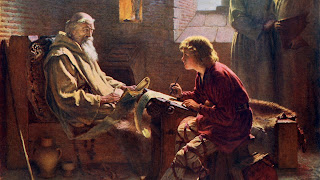For those of you who have been around a while, I haven't done this classic rant of mine since 2016. Here it is:
Ascension Thursday
Today is the Feast of the Ascension, in Dioceses that still celebrate it correctly, if your diocese has not re-instituted the Mass Obligation though it is not a Holy Day of Obligation with all its requirements, but it usually is…..you have been warned! Even so, it is a big deal.
Many bishops throughout the USA have moved the celebration to next Sunday so as not put Catholics out by asking them to go to church in the middle of the week…..I’m glad Our Lord didn’t feel like he was being put out during the whole scourging/crucifixion thing.
The Ascension commemorates the elevation of Christ into heaven by His own power in presence of His disciples the fortieth day after His Resurrection. "I go to return to My Father and your father; to My God and your God." After Christ’s Ascension the first “Novena” began; the following nine days until Pentecost and the descent of the Holy Spirit. A man asks a Franciscan and a Jesuit if it would be proper to pray a novena so he could have a Maserati. The Franciscan asks, "What's a Maserati?" but the Jesuit asks "What's a novena?"
Anyhoo, every year I get an email from one or another of you saying I am too critical with my complaint about moving this feast:
“I believe you are being a tad uncharitable in your sweeping condemnation of those, who’s Ordinaries have removed the obligation of attending Mass today. There are lots of economic reasons for their actions.”
To which I say: there are Masses all throughout the day and evening; vigil the night before and the evening of Thursday, I am certain that most people who work can find a Mass to go to with a little sacrifice. As always there are unique situations like; if one is sick, cares for one who is sick or if one is required to work for reasons of the Public Good like Nurses, Firemen, EMTs Paramedics and Police, they are naturally dispensed as always. This didn’t seem to be a problem on Ash Wednesday did it? And Ash Wednesday is not a Holy Day of Obligation. People jumped over one another to “get ashes,” even with this pandemic going on……
Ostensibly, the reason to transfer the feast to Sunday is, a way to expose more people to the mystery of the Ascension of the Lord. Let’s be honest, included in that calculation was also the notion that it is tooo haaard for people to go to Mass also on Thursday. “Mass twice in a week? Tooo haaard!” Fast 2 days in the whole year? Tooooo HAAAARRRRD! No meat on Friday? TOOOOO HAAAARD! We have to get ordained in May of 2013…..TOOOOO HAAAARD! STOP IT!!!
The big complaint I have is, let’s face it, most people don't even try, "I was too tired after work," or "The kids are all brats." is not a valid excuse. You can see many of them pouring out of Madison Square Garden or Yankee Stadium, or The Borgata in Atlantic City every day of the week...they have no problem finding time in the middle of the week to do that....It is to these folk I am speaking not uncharitably but with love, in my own sarcastic way which everyone on this list knows and understands.... since one of the Spiritual works of Mercy is to Admonish the Sinner I am doing just that. Vatican II reaffirms the fact that we are all called to holiness..not perfection, so we should at least try. This is not a question really of Catholic requirement it is rather asking people to take advantage of the rich, redemptive, resources of Holy Mother Church. Look at it this way, you don’t have to go to Mass today…..you get to go to Mass today!
My present view of humanity suggests that when Holy Mother Church lowers expectations regarding the liturgy, people get the hint and lower their own personal expectations of themselves. Maybe…the feast just isn’t that important. As a matter of fact, maybe none of this Catholic stuff, with all these rules, is that important. This is what happened with lowering expectations about Friday abstinence (hardly anyone pays attention to it anymore), going to confession regularly, and confession of all mortal sins, the Eucharistic fast, dressing appropriately for Mass, etc. etc. etc. “Gee Tom I forgot I was scheduled to serve the 9 o’clock Mass, my kid had a soccer game.” If you change how people pray (or tell them they don’t have to) you change the way people believe. There is a reciprocal relationship between our prayer and our belief. Lex ordandi – Lex credendi. Finally, I cannot conceive of a situation where the church has not made allowances for someone to not go to church within reason on a holy day of obligation when they legitimately cannot.















